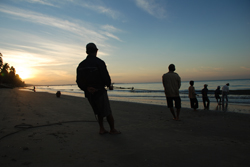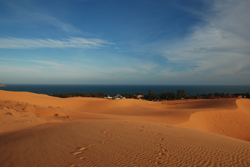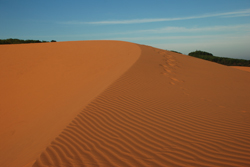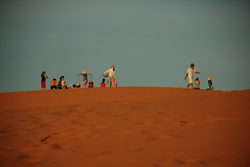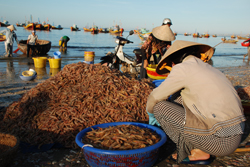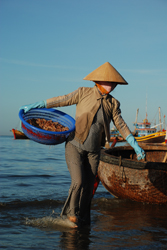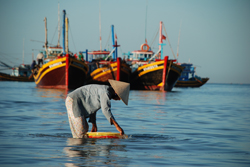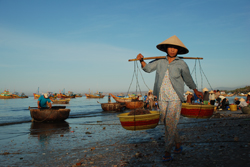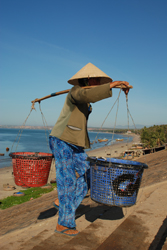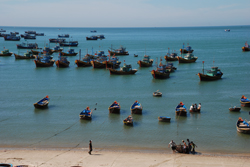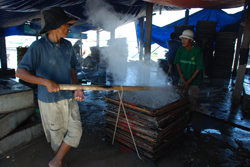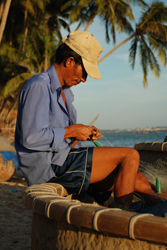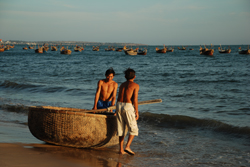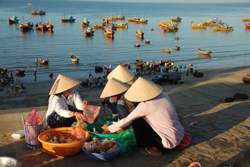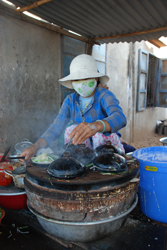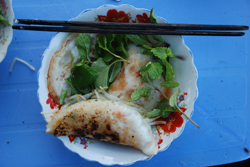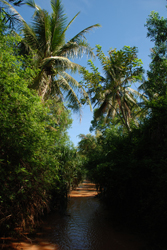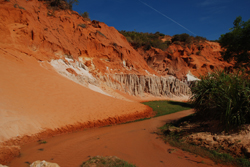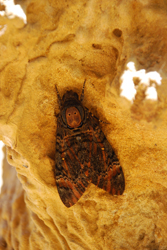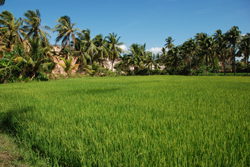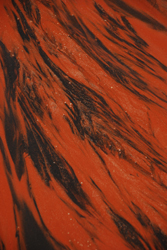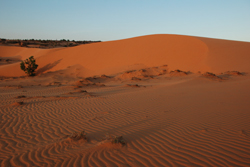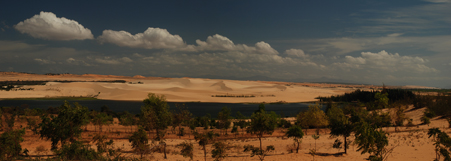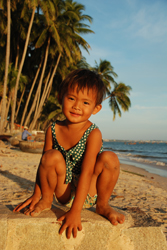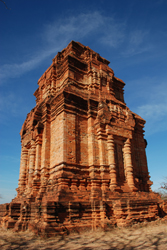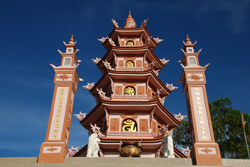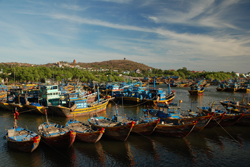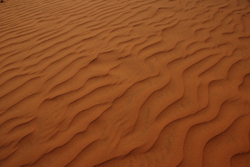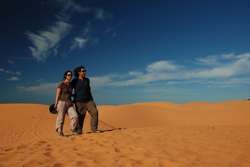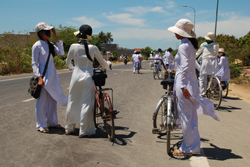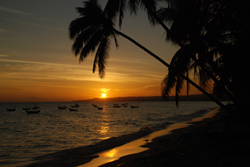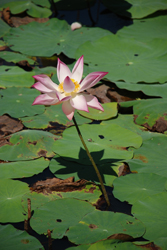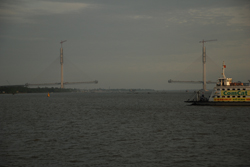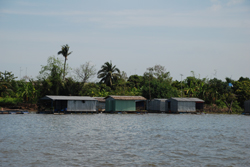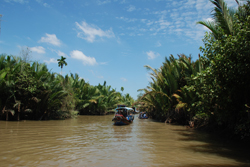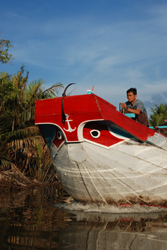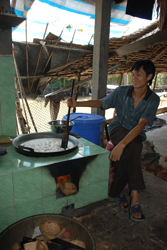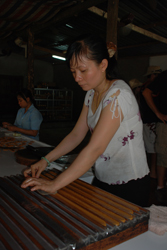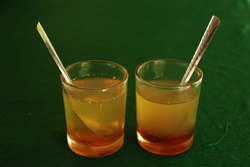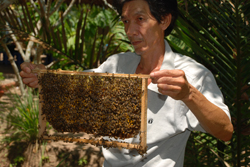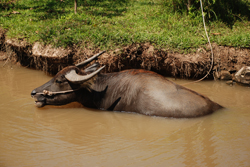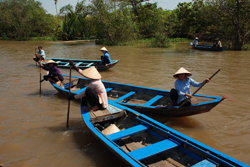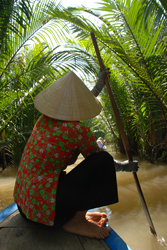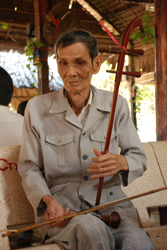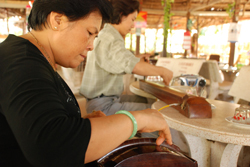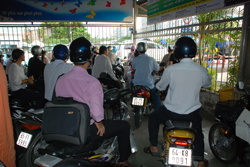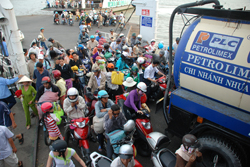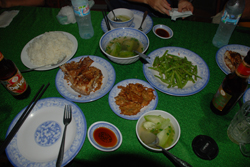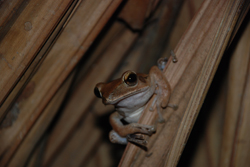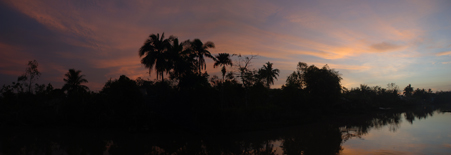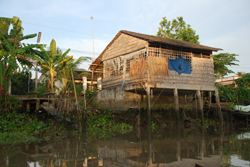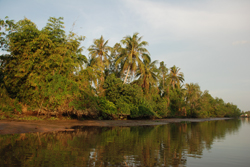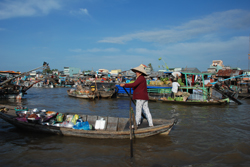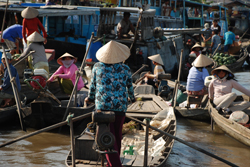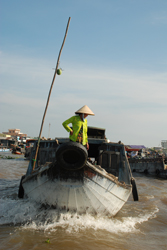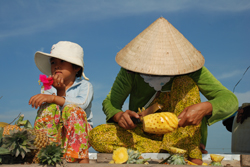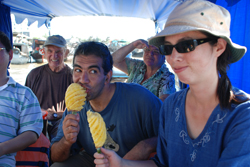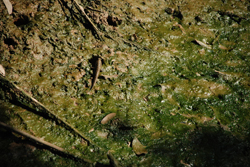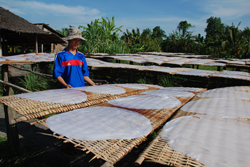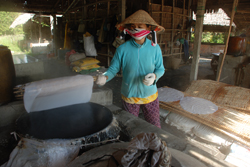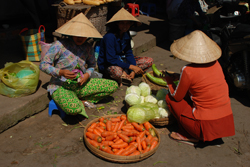Mui Ne: A Vietnamese Fishing Town
25 February, 2009, 02:52 am in "Vietnam"
If you wake up early enough you can see fishermen who look like they are playing tug-o-war with the sea-- and winning as their huge nets-- marked with floaters get closer to the shore.
We got up early to see the sunrise from the red dunes. The sands were cool from the night and we walked barefoot along them. The sky had been pinkening as we rode the motorcycle to them but we arrived with plenty of time before the sun appeared above the clouds. There were already some people on the dunes with kids holding plastic sheets for sliding, waiting patiently next to them. The dunes were marked with the shadows of footprints of the previous day which were slowly becoming hidden by the blowing sand. Lizard and bird footprints ran along the sands as well.
After the sun rose the sled kids prepared the sleds for their passengers. They piled sand onto the plastic, dragged it to a slope, and threw the sand down the slope. I'm not sure why-- maybe it makes sliding easier. The passengers sat in the remaining sand pile. Maybe it added to the weight or evened it out. Then the kids pushed them until they slid down the hill. It seemed kind of sad and strange seeing the little kids doing all this for adults. They should have been the ones sliding.
After that we headed back to Mui Ne looking for breakfast. We stopped at the beach which was a flurry of activity. They had been hauling the nets when we passed earlier and now the contents of the nets and the fishing boats were in piles being sorted: squid, shrimp, in various sizes, scallops, fish, eels, and crabs. Basket boats went back and forth between shore and fishing boats. People would wade into the water and retrieve plastic baskets or nets of seafood and carry them onto the beach. It was a busy scene and people worked fast-- but it wasn't chaotic.
Some women had scales. Some money was exchanged. Some women carried heavy loads on the ends of bamboo sticks. From the road above, their round bamboo hats looked like clusters of mushrooms where the women gathered working. The beach was littered with piles of scallop shells. Women cleaned the shellfish in the ocean and opened the scallops with knives or metal spatulas.
It was a rush that seemed to last no more than a couple hours as the seafood was sorted, sold and carted off-- perhaps to be taken to other towns inland while it was still fresh. I thought how fascinating this working beach was-- morning with the nets being pulled, then seafood sorted. Later it is covered with wood/net flats full of salted fish drying in the sun. The harbor has cheerful fishing boats painted red, yellow and blue. In the evening the basket boats, which are used for fishing and carting loads back and forth between fishing boats and shore, are pulled onto the beach and the fishermen clean and repair their nets.
For breakfast we found a street vendor across from the beach who made banh xeo, delicious thick rice pancakes stuffed with pork, shrimp, and bean sprouts and fried/steamed in an interesting blackened ceramic pancake maker with lids to cover each round pancake space. They were served with fresh herbs in a bowl of sweetened fish sauce. They were delicious and were 3000 each (we ate 3 each). They further convinced us of the tragic tastelessness of the restaurants on the resort row.
After breakfast we got some delicious coffee at a cafe in town. Then, armed with a photo and the name in Vietnamese, we went off in search of the Red Canyon, a stop on all the paid tours of the area. We still couldn't find it and asked a security guard. He gestured that it was closed but didn't speak any English so motioned to us to ask the receptionist. She said it was 1 km back. 1 km back was a fenced area with signs in Vietnamese. They looked like warning signs, especially a red metal one. However, red is also the color of good luck in this area so I figured I could be misinterpreting. The gate wasn't locked so we went in. I walked ahead up the path until I saw a sign in Vietnamese with a picture of a skull and crossbones. This didn't leave much open for interpretation so we decided we were probably in the wrong place. Up the road we saw a sign in English reading, “Danger- Area closed for restoration”. A bit farther we asked at a military post and were told that it was the red canyon but it was closed. It looked like bougainvillea flowers were being planted. I wondered if they were going to make it a true “tourist attraction” and add walkways, souvenir shops and a ticket price.
Back in Mui Ne we stopped at the Fairy Stream. The Stream is a shallow sandy stretch of water. We walked barefoot up it in the shade of palms, bamboo and other trees. The stream soon led to interesting white sandstone formations like towers of stalactites eroded by the wind. Rising above them were red sand dunes and beyond that a vivid blue sky. Little springs sent streams trickling down sand flats into the main stream. The sand colored the water red or milky. At the end of the stream were several little water falls.
Back in Mui Ne we stopped at the Fairy Stream. The Stream is a shallow sandy stretch of water. We walked barefoot up it in the shade of palms, bamboo and other trees. The stream soon led to interesting white sandstone formations like towers of stalactites eroded by the wind. Rising above them were red sand dunes and beyond that a vivid blue sky. Little springs sent streams trickling down sand flats into the main stream. The sand colored the water red or milky. At the end of the stream were several little water falls.
After the day cooled a bit (around 4:30) we rode out to an empty beach a bit North of the dunes. We walked along the water watching little, almost transparent crabs skittering across the sand.
We headed back to the dunes for sunset but since they were crowded, took the new Phan Thiet road to the other side which was empty. The setting sun turned them orange and their arcs and curved ridges were unbroken by slides or footprints.
Riding by the market beach, the fishing boats were black shadows against silvery blue with the pink and orange sky behind. Farther out we could see the lights of the fishing boats looking like a town across the water.
Mui Ne: Cham Towers, White Dunes, and Sad Shakes
24 February, 2009, 03:52 am in "Vietnam"
Mui Ne is a little fishing town-- at least that's what it's like once you get past the stretches of beach resorts that border it. It must be strange to be a local fisherman and see your town's outskirts taken over by pale foreigners doing their best to transform themselves into lobsters. We are staying in the middle of the resort stretch. The end closest to Phan Thiet seems more expensive (starting with golf resorts by the golf course and then just simple luxury beach resorts). Towards the middle there are some mid-range options and the end closest to the town has a few budget establishments.
The towns of Mui Ne, Phan Thiet and the resort strip are all located on a curved bay which provides sunrises and sunsets on the right and left hand sides.
Our first night here we walked on the beach a bit, watched fishermen working and children swimming. I also got unwillingly pulled into a game where 2 children, a boy and a girl, pretended to stab me with a plastic knife. Little brats...
The towns of Mui Ne, Phan Thiet and the resort strip are all located on a curved bay which provides sunrises and sunsets on the right and left hand sides.
Our first night here we walked on the beach a bit, watched fishermen working and children swimming. I also got unwillingly pulled into a game where 2 children, a boy and a girl, pretended to stab me with a plastic knife. Little brats...
We've rented a motorbike and biked to Phan Thiet, the nearest city. Our first stop was the Cham towers which are stone/brick structures similar to some of the less impressive Angkor structures, but even less impressive. We got tailed by some kids who seemed to want us to pay them for the privilege of being annoyed by them...more little brats. There is a pagoda near the towers as well. The Cham culture was an early culture from this area so I figured we should at least see the tower.
Phan Thiet has a picturesque river full of fishing boats, a small market, and lots of stores and businesses. It's a bustling town. We were searching for some cheap food. The food in the resort strip is not only fairly tasteless it is also over priced 2-3x what the price should be. In town we found filling meals of com (rice) with vegetables, soup and tea. Rowshan had chicken and I had eggs and a piece of mushroom egg loaf. Rowshan's was 15,000, mine was 12,000. Vegi fried rice on the strip is usually 20-35,000.
All the hotels and tour agents offer a tour of the Mui Ne region to see the Red Dunes, White Dunes, Fairy Stream, and Red Canyon. We rented a motorcycle and decided to do the tour on our own. After a brief stop at the Red Dunes (which were hot) we biked alongside empty beaches to the White Dunes, about 20km outside of Mui Ne. At first we missed the turnoff but found a view of one side of the lake and birds wheeling overhead. We found the road and saw the White Dunes which looked like swirls of soft butter rising beyond Lotus Lake. The dunes were hot and the winds stirred up a mist of sand about 1 foot from the dunes' surface.
On the way back we biked through a bit of traffic from a school getting out. I was impressed how the girls managed to keep their school uniforms so clean while biking.
We had a sad dinner and fruit shake. It is a tragedy indeed when establishments in a beach resort area in tropical countries can't make decent fruit shakes. We consoled ourselves by going to a different restaurant that makes tasty banana chocolate pancakes. There the owner's 2 little girls immediately came up to Rowshan. The oldest violently squeezed his nose. This soon deteriorated into some rather rough game involving the girl hitting Rowshan and trying to grab his nose. He quickly tired of this and distracted them with a hand slapping game which they loved so soon we were stuck playing that. Then they wanted to play horse by standing on our legs and holding our hands as we bounced. Worrying they were going to fall since they were jumping and twisting about. Rowshan started the “Which hand has the shell?” game which kept them occupied until our pancake came and they were taken to their house. The kids here play rough. Their parents must be exhausted.
Relaxing in the Mekong Delta
21 February, 2009, 02:45 am in "Vietnam"
We decided to brave an increase in heat and humidity and take a tour of the Mekong Delta. I always feel guilty taking tours like this because I feel we should do it ourselves so as to better experience the true life of the people in the region (blah blah blah). Well... I'm glad we went on this tour because we were tired and it was a relief not having to deal with finding transport, hotel, bargaining for boats, etc. etc. Consequently for $25 each plus various drinks and a meal (lunch) we got 2 relaxing days including a delicious dinner, a night at a guest house on the riverside, no worries and lots of boating around the Mekong. We also met some friendly people.
The tour started out with an uneventful bus ride of a couple hours to the Mekong Delta region. We had a toilet/coffee break at a little tourist stop with a garden, pools, thatched buildings, and a statue of a water buffalo. The highlight was the amazing iced coffee, made with rich coffee brewed thick and combined with sweetened condensed milk and ice. It was chocolaty.
The tour started out with an uneventful bus ride of a couple hours to the Mekong Delta region. We had a toilet/coffee break at a little tourist stop with a garden, pools, thatched buildings, and a statue of a water buffalo. The highlight was the amazing iced coffee, made with rich coffee brewed thick and combined with sweetened condensed milk and ice. It was chocolaty.
In My Tho we left the bus and boarded a boat which took us along the river and between islands. Our guide pointed out a new bridge which had just opened about a month ago. There are several bridges in various stages of completion in the Mekong Delta. On one hand it is great to see the attention to infrastructure and making things easier for people to access the area. But it is also sad to think that the ferries will go.
The islands are still most pleasantly accessed by boat. There are 4 main islands named for 4 sacred Chinese animals: Dragon which stands for power, Phoenix for freedom, Turtle for longevity, and Unicorn for wisdom and kindness. Dragon Island was lined with little floating houses with gray corrugated metal walls. Underneath were fish farms.
We headed to Unicorn Island. Palm trees with big leaves sprouting from their bases, lined the water. The air was heavy with heat and humidity but a breeze softened the climate a little. Boats plied the waters, some fishing, some transporting. Even industrial gray chunky boats had eyes like the more traditional wooden long boats. The eyes give the boats a quizzical dazed expression like a surprised paramecium.
Our first stop was a coconut candy factory. We were shown how they used a machine to grind the coconut then press the oil out. The coconut was boiled with sugar and other ingredients on a fire made from coconut husks, then poured out to be kneaded, shaped, cut and wrapped. Everything was done by hand. The candy wrappers quickly and deftly wrapped pieces in rice paper. By the water, some men were using mud to build up the land.
From there we visited a small apiary and had delicious honey kumquat tea. We took a walk, stopping by a pagoda to the goddess of mercy on the way, to a restaurant where we had a rather unexciting lunch.
After lunch we went down another path to a different port where the boat had come around from the other part of the island to meet us. On the boat we realized we were missing 4 people. The guide (who was a dork) had announced suddenly we were leaving and the 4 had been left at the restaurant. Not knowing where to go, they went back the way they came so we took the boat back to the apiary. Instead of apologizing, the guide told everyone how stupid they had been for going back instead of knowing to go down the right path. Rowshan told him he should have made sure everyone was with him before he took off. The guide did not acknowledge he was at fault at all.
We were taken to another island and transferred to small rowboats for a canal tour. We donned Vietnamese hats which we were grateful for since the sun was so hot and the hats provide lots of shade. The boats each were rowed by 2 women-- 1 in front and 1 in back, each looking extremely picturesque in their comfortable but fitted clothing and their faces partially hidden by their hats.
The next stop was for tea and fruit sampling. We were served plates with pineapple, saporillas which look like they'd taste like apricots but taste like figs, dragon fruit, beautiful with its fuchsia peel and white flesh speckled with black seeds, and custard apples. As we ate we were treated to a performance of traditional Vietnamese music sung by several different singers and accompanied by a stringed, long necked mandolin, spike fiddle, zither and an interesting instrument made up of 1 string on a piece of wood with a handle that, when bent, made the sound like a musical saw.
We went back to shore and 8 of us boarded a van to go to Can Tho while the rest went back to HCMC. To get to Can Tho we had to take a ferry across the river. We had to get off the bus and walk on the boat. Our guide said this was because there had been an accident where a bus fell in the water and a couple tourists died. Apparently tourist lives were worth more than locals since the local bus passengers remained in their vehicles. We had to wait with all the motorbikes.
In Can Tho, we separated again: 4 staying in town in a hotel and Fritz and Beatrice(a couple from Switzerland), Rowshan and I were taken to motorbikes. We learned we had a 25 minute ride to the village for our home stay.
The sun was setting and the clouds were lined with fire. Rowshan and I enjoyed our ride. Rowshan freaked out his driver by trying to get off the bike on a bridge to take a picture of the beautiful sky.
It was dark by the time we got to the home stay which was right on the river. It was not really a home stay, more of a guest house built using traditional techniques. The walls and rooms were made of wood and bamboo, and covered with palm thatch. Inside were Western beds, and a bathroom with shower. In front of the rooms was a terrace with tables and chairs.
When I arrived Rowshan was already talking to an Asian man with a broad smile. Rowshan had thought he was the owner because he had run up to greet him. “No! No! I'm also a guest,” Peter explained. “It is just I've been here since 3:30 and I'M BORED!”
Peter and his wife, Patty, were from Australia though originally they were from Cambodia. We had a delicious dinner of fried fish with green beans, shrimp fritters, rice and soup. They actually gave us enough rice, too. Of course, the Mekong is the rice basket of Vietnam and Vietnam is the second largest exporter of rice after Thailand. We took our time and had an enjoyable dinner conversation with our new acquaintances until the mosquitoes forced us to retire for the night. The village wasn't as quiet as we expected it to be since motorcycles zoomed by now and then on the street side and occasional motorboats went by on the river side-- full of fruit for the market.
The sun was setting and the clouds were lined with fire. Rowshan and I enjoyed our ride. Rowshan freaked out his driver by trying to get off the bike on a bridge to take a picture of the beautiful sky.
It was dark by the time we got to the home stay which was right on the river. It was not really a home stay, more of a guest house built using traditional techniques. The walls and rooms were made of wood and bamboo, and covered with palm thatch. Inside were Western beds, and a bathroom with shower. In front of the rooms was a terrace with tables and chairs.
When I arrived Rowshan was already talking to an Asian man with a broad smile. Rowshan had thought he was the owner because he had run up to greet him. “No! No! I'm also a guest,” Peter explained. “It is just I've been here since 3:30 and I'M BORED!”
Peter and his wife, Patty, were from Australia though originally they were from Cambodia. We had a delicious dinner of fried fish with green beans, shrimp fritters, rice and soup. They actually gave us enough rice, too. Of course, the Mekong is the rice basket of Vietnam and Vietnam is the second largest exporter of rice after Thailand. We took our time and had an enjoyable dinner conversation with our new acquaintances until the mosquitoes forced us to retire for the night. The village wasn't as quiet as we expected it to be since motorcycles zoomed by now and then on the street side and occasional motorboats went by on the river side-- full of fruit for the market.
After breakfast we boarded a motorboat for the 50 minute trip up the river to meet with the rest of our tour group. The river passed thatched houses (some with corrugated metal for walls. People squatted on porches brushing their teeth, or sat in boats preparing for their work-- fishing or transporting goods.
Though it was no later than 7, the river was active. But then, the morning is probably the best time on the river. Kingfishers flew across the water, perching on trees. The air hadn't started to sizzle yet and the sun was still low enough that the river was shaded.
Once we joined our group, thankfully in a covered boat since it was becoming very hot, it was a short hop to the floating market. I had imagined lots of little wooden boats with various wares but in fact it was more of a wholesale market where larger wooden boats sold fruits and vegetables to smaller boats which in turn would travel down the canals and sell to the people there. There was a couple smaller boats but they were mostly selling drinks and fruits to the large number of tourist boats drifting through. Actually, we didn't see much buying or selling and speculated that the buyers knew tourists would jam up traffic around 8-9 so did their business earlier (or later). Our guide explained there are 3 different boats: one that tows big loads, buyer boats, and seller boats with their wares advertised by hanging a piece of fruit or vegetable from a bamboo pole in the prow, even though you usually could see piles of coconuts, pineapples, and other fruits. The vegetable boats seemed to sell a variety-- evident from their bamboo poles with a row of different vegetables hanging from them. Our guide also told us if there was a piece of thatch hanging from the pole it meant the boat was for sale.
The floating market was established 200 years ago to sell produce to smaller boats which could move it through the 1000+ canals. The floating market solved the problems of lack of trucks and bridges to bring the produce through the area. I wonder if all the bridge construction is going to make the market obsolete. We stopped for pineapple from one of the boats.
Next stop was a family run rice noodle factory. As the boat had pulled up to the dock, we could see strange fish jumping in the mud propelling themselves with their fins. I named them evolving fish because they looked like the pictures of fish crawling out of the water onto land.
The factory was an open air roofed structure. There were tanks for soaking rice and a machine for grinding it. According to our guide, the prices per kilo for rice and noodles are the same. I couldn't figure out why they bother unless they maybe get money from tourists stopping by. Our guide said they made their living from raising pigs who eat the waste from the noodle making process. The noodles are made from 50% rice and 50% casava (tapioca). The mix is spread in rounds onto a flat cooker. The rice husks were used as fuel. Then the ash was taken to the rice fields and used as fertilizer. The rice paper is taken off the steamer with a wicker basket club, and set on woven bamboo trays to dry in the sun.
After they are dry they are fed into something like a shredder which cuts them into noodles. The noodle production only occurs in the morning. Maybe it really is only occurring for tourist groups. We visited the pigs as well-- 2 big pregnant sows and their piglets who were already quite big and were living in another pen.
We stopped at a market where Rowshan caught a couple evolving fish who had leaped out of their bucket and were trying to escape across the market. Then, after a boat trip back to Can Tho, and lunch (Rowshan and I escaped to a street seller with curry pho-- not burning spicy but it sure made my nose run to the amusement of the local woman sitting across from us) we headed back to HCMC.
It was a long trip back since the air conditioner didn't work well. Rowshan managed to improve its performance by jamming empty water bottles into the holes towards the front of the vehicle where the air was escaping before it reached the rest of the vehicle. The trip was made a lot easier because we were able to talk to a couple from Canada, Beverley and Brian. They had been in the foreign service so had traveled extensively as well as lived in many interesting countries.
Powered by My Blog 1.69. Copyright 2003-2006 FuzzyMonkey.net.
Created by the scripting wizards at FuzzyMonkey.net..
(Code modified by Rowshan Dowlatabadi)
Created by the scripting wizards at FuzzyMonkey.net..
(Code modified by Rowshan Dowlatabadi)



